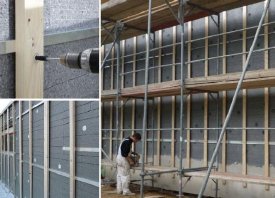Back-ventilated curtain facades extending to the high-rise building limit can now be efficiently thermally insulated with expandable polystyrene (EPS). This innovation became possible thanks to insulation materials made from Neopor, the EPS from BASF.
 Back-ventilated curtain facades extending to the high-rise building limit can now be efficiently thermally insulated with expandable polystyrene (EPS). The Swiss insulation material manufacturer swisspor uses Neopor, the EPS from BASF, in its patented facade system swisspor Lambda Vento. The Neopor insulation panels have a tongue and groove all the way round and, along with the spacer bolts which are placed at regular points and fix the sub-structure, they form a structure which is effectively free of any heat bridges. They are secured to the substructure with insulation material holders, and so do not have to be glued. Photo:BASF/ swisspor, 2009
Back-ventilated curtain facades extending to the high-rise building limit can now be efficiently thermally insulated with expandable polystyrene (EPS). The Swiss insulation material manufacturer swisspor uses Neopor, the EPS from BASF, in its patented facade system swisspor Lambda Vento. The Neopor insulation panels have a tongue and groove all the way round and, along with the spacer bolts which are placed at regular points and fix the sub-structure, they form a structure which is effectively free of any heat bridges. They are secured to the substructure with insulation material holders, and so do not have to be glued. Photo:BASF/ swisspor, 2009
The Swiss insulation material manufacturer swisspor uses Neopor in its patented facade system swisspor Lambda Vento for back-ventilated curtain facades. The system with insulation panels made from Neopor is approved by the German Institute for Construction Technology, Berlin, and offers considerably better thermal insulation (?R = 0.031 or 0.032 W/m*K) than conventional systems, is impervious to moisture and can be used in the renovation of older buildings and the construction of new ones.
Space-saving, with few heat bridges and easy to assemble
The compact and space-saving structure can be fitted up to the high-rise building limit (22.5 meters) as the fire protection which is prescribed here is guaranteed by fire locks and fire barriers on each story. Compared with conventional back-ventilated curtain facades with mineral wool, the system from swisspor is impervious to moisture and thus dimensionally stable, resistant to ageing and rot-proof. The Neopor insulation panels have a tongue and groove all the way round and, along with the spacer bolts which are placed at regular points and fix the sub-structure, they form a structure which is effectively free of any heat bridges.
The multilayer outer wall structure - consisting of insulation panels, a wooden substructure with air gap, and outer cladding - can be assembled quickly, safely, and easily. The insulation panels, which are approved in thicknesses of up to 200 mm, can be cut and processed by hot wire without any dust or waste. They are secured to the substructure with insulation material holders, and so do not have to be glued. This means that the facade can be completely deconstructed if necessary, the components are therefore reusable or recyclable.
This facade structure provides plenty of design possibilities for individual, aesthetic and at the same time weather-resistant cladding for facades, e.g. eternity facade panels and plaster support plates with different coatings.
In Germany, the system will be presented for the first time at BASF's stand during the dena congress "zukunft haus 2009" ("future house 2009") taking place from November 24 to 25 in Berlin. At present, the Anne Frank day nursery in the German state of Mecklenburg-Vorpommern is undergoing high-quality refurbishment as part of the dena project "Efficient homes" (acc. to German Energy Saving Ordinance (EnEV) 2007 for new buildings: -40%). Two facades were designed as a back-ventilated curtain facade using the swisspor Lambda Vento system.
Insulation material for energy-efficient applications
Neopor is an advanced version of the classic white insulation material Styropor. BASF manufactures the black, expandable beads from polystyrene. Processors foam up the beads and process them into silver-gray blocks and molded parts for various applications, in particular for insulating buildings. Insulation materials made from Neopor are silver-gray because they contain finely distributed graphite particles which act like miniature mirrors reflecting the thermal radiation and thus reducing heat losses. The insulating effect is thus increased by up to 20 percent. This saves heating costs and enhances the value of buildings in an environmentally friendly way.